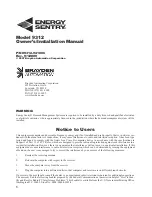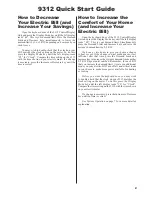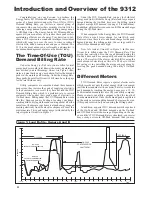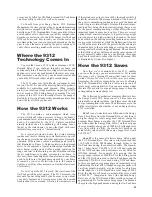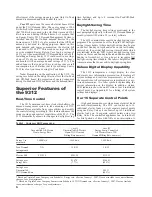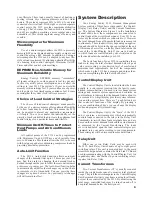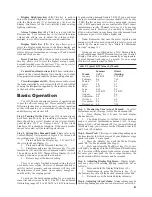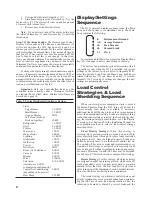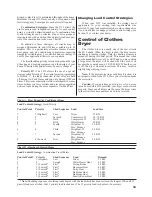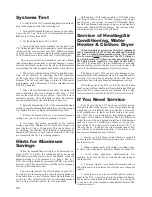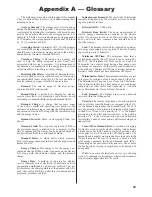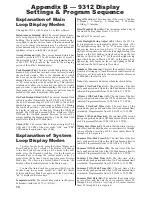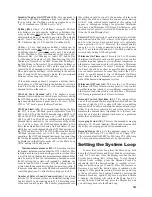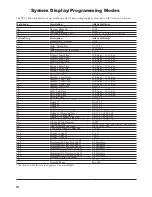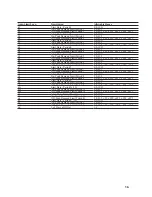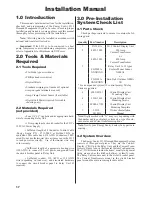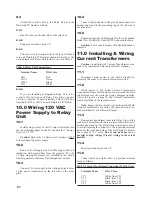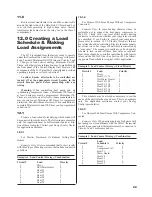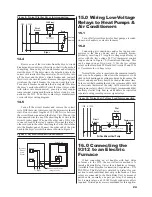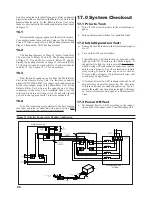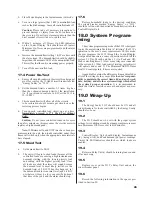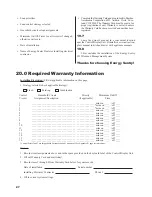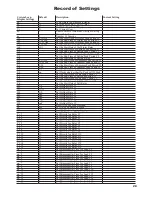
Appendix B — 9312 Display
Settings & Program Sequence
13
Explanation of Main
Loop Display Modes
This applies 9312’s with Version 3.3 or later software.
Instantaneous Demand (id):
The current demand pres-
ently being drawn by the electrical service of the home or
building. This is useful for determining how much energy
is required to operate various loads so that an understand-
ing of your energy requirements may be achieved. Your
actual demand may be compared to the typical residential
appliance rates given in Table 3 on page 9.
Average Demand (Ad):
The average demand which has
accrued over the last 15, 30 or 60-minute interval, as set by
the averaging period “AP” in system programming mode
of the 9312. This should be the same as the averaging
period of the utility’s demand meter.
Peak Demand (Pd):
The interval with the highest average
demand (Ad) which has occurred (since last reset) during
the On-Peak periods. This is the demand level which
has been set on the electric meter and consequently, the
demand that you will be billed for. To reset, set the 9312
to “Pd” mode and press the Reset Peak key. This indicator
is intended to allow you to monitor your daily or weekly
peaks in order to gain an understanding of how and when
these peaks occur. In this way, energy use patterns may be
modifi ed, if desired, to minimize these peaks.
On-Peak Demand Limit (dL):
The current demand limit
which is in effect. Adjustable from 2.0 KW to 49.5 KW in
the 40 KW demand range (4 KW to 99 KW in the 80 KW
demand range -- see demand ranges on Page 14). During
the On-Peak period(s), the On-Peak demand limit will
be displayed, and can be changed. During the Off-Peak
periods, the Off-Peak demand will be displayed. While
Off-Peak, the On-Peak demand limit can be viewed by
simply pushing the demand limit key. The On-Peak limit
must be less than the Off-Peak limit.
Clock (CL):
The current time between midnight (12:00
AM) and 11:59 PM of the next night. “AM” and “PM”
LEDs indicate appropriate time of day.
Explanation of System
Loop Display Modes
To enter System Loop, press the Alarm Volume and
Reset Peak keys for 5 seconds. The display will change
to the fi rst System Loop setting: dE. To move to the next
mode, press the Demand Limit key. Use the Increase or
Decrease keys to change the current mode’s value. To
escape from the System Loop at any time, press Display
Mode key. If no keys are pressed within 2 minutes, the
display will automatically return to the Main Loop.
To enter the Auto-Limit Loop, you must fi rst be in the
System Loop in any mode except “dr”. Push the Alarm
Volume and Reset Peak keys again until the fi rst setting
“d1” is displayed. Release keys.
Temperature (dE):
The current temperature, in (dE)grees
Fahrenheit, inside the 9312’s C/D Unit.
Day of Week (do):
The current day of the week. 1=Sunday,
2=Monday, 3=Tuesday, 4=Wednesday, 5=Thursday,
6=Friday, 7=Saturday.
Date (Month & Day) (dA):
The current month and day of
the month. Setting range from 1/1 to 12/31.
Year (Yr):
The current year.
Auto Daylight-Saving Adjust (dS):
Allows the 9312 to
be programmed to automatically adjust the clock (CL)
for daylight-saving time. Set to “0” in areas where day-
light-saving time is not used. Set to “1” for the pre-2007
daylight-saving time schedule where daylight-saving time
begins on the fi rst Sunday in April and ends on the last
Sunday in October. Set to “2” for the new daylight-saving
time which began in March of 2007. In this mode, day-
light-saving time begins on the second Sunday in March
and ends on the fi rst Sunday in November.
Number of Seasons (ns):
This sets the number of seasons
from 0-4 allowing up to four different seasonal time sched-
ules per year. This needs to be the same number of seasons
as defi ned by the electric rate.
Note:
Only summer and winter schedules shown below.
Winter 1 On-Peak Time (A1):
The start time of the fi rst
daily peak period and when the On-Peak demand limit is
initiated. Programmable from 12:00 AM to 11:59 PM.
Winter 1 Off-Peak Time (A2):
The end time of the fi rst
daily peak period and when the Off-Peak demand limit is
initiated. Programmable from 12:00 AM to 11:59 PM.
Winter 2 On-Peak Time (A3):
The start time of the
second daily peak period and when On-Peak demand limit
is initiated. Programmable from 12:00 AM to 11:59 PM.
Winter 2 Off-Peak Time (A4):
The end time of the second
daily peak period and when Off-Peak demand limit is initi-
ated. Programmable from 12:00 AM to 11:59 PM.
Winter Start Date (Ad):
The date that the winter rates go
into effect, and the date the above winter timers A1 through
A4, are effective. A setting of 0/0 causes winter times A1
through A4 to be ignored.
Summer 1 On-Peak Time (S1):
The start time of the fi rst
daily peak period and when the On-Peak demand limit is
initiated. Programmable from 12:00 AM to 11:59 PM.
Summer 1 Off-Peak Time (S2):
The end time of the fi rst
daily peak period and when the Off-Peak demand limit is
initiated. Programmable from 12:00 AM to 11:59 PM.
Summer 2 On-Peak Time (S3):
The start time of the
second daily peak period and when On-Peak demand limit
is initiated. Programmable from 12:00 AM to 11:59 PM.
Summer 2 Off-Peak Time (S4):
The end time of the
second daily peak period and when Off-Peak demand limit
is initiated. Programmable from 12:00 AM to 11:59 PM.
Summer Start Date (Sd):
The date that the summer rates
go into effect, and the date the above summer timers S1
through S4, are effective. A setting of 0/0 causes summer
times S1 through S4 to be ignored.



